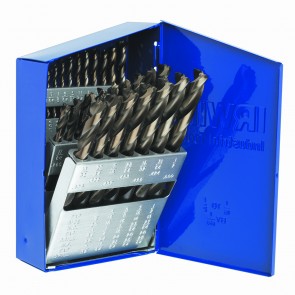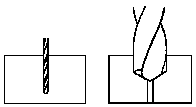Drill Bits 101
Drill bits are cutting tools used to create circular holes, they may be refered to as bits or drills. They come in many different styles and sizes, some are specialized, others such as twist bits are universal in their application, cutting, wood, metal, plastic and many other materials. Many different materials are used to make drill bits, low carbon steel is used for wood bits, high carbon steel is used for wood or metal. High speed steel (HSS) has generally replaced the carbon steels as it is more resistant to high heat so can drill at greater cutting speeds. |
 |
|
Auger Bit
These are also referred to as ship-builders bits, the auger design and long length make drilling deep holes much easier as the chips are removed very efficiently. Use with care when drilling thin material because the auger will catch on the edge of the material and pull the bit through very quickly. Brad Point Bit
Brad point bits come in two styles, designed to drill either hardwood or softwood, these bits are recommended for drilling holes for dowels. Dowel Bit
Dowel bits are similar to brad point bits but drill a cleaner and more precise hole.
Expansion Bit
These have an adjustable cutting bar that make it possible to drill any size hole, a shorter cutting bar is used to drill smaller holes. Holes smaller than the holder cannot be drilled with this bit. Forstner Bit
These bits are for precision work, where a clean hole is required. It is also possible to drill overlapping or angled holes with these bits. Masonry Bit
Masonry bits are a variation of twist bits with inserts of tungsten carbide brazed onto the end to provide the cutting edge. Spade Bit
These are an inexpensive bit suitable for general work, they do not have good chip clearing ability and tend to split thin material. Twist Bit
This is the most common type of drill bit, they are used for both wood and metal. They are available in many grades and styles. Using Drill Bits Always wear eye protection. Don't apply to much pressure on small drill bits Ease up on pressure when drill breaks through material. The larger the drill bit the slower the speed of the drill. Use a vise or clamp to hold the material to prevent it from spinning if the drill bit catches. To prevent wood splintering when the bit exits clamp a piece of scrap material to the back of it. If possible stop drilling just as the point of the bit comes through the material, then finish drilling the hole from the other side. Drilling Metal
When drilling a large hole in metal a small lead hole helps to relieve the feed pressure required. Extra Long Drill Bit To make an extra long bit to drill through wood or sheet rock pound the end of a iron rod flat, grind or file the end to a point and the sides to desired width. More About Drills
|




